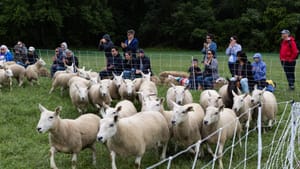Stay in the Loop
BSR publishes on a weekly schedule, with an email newsletter every Wednesday and Thursday morning. There’s no paywall, and subscribing is always free.
Sheep thrill
PIFA 2018: Ann Carlson's 'Doggie Hamlet'

Doggie Hamlet lets you get at least one thing out of the way right up front: working border collies do not care about your clapping. But that’s how the audience greeted a furry costar of Ann Carlson’s PIFA show when the dog first entered the large, rectangular pen on Belmont Plateau on the heels of a herd of small, close-shaven sheep. The sheep announced themselves with a benign barnyard odor, a pleasant counterpoint to the city skyline in the distance.
As the Kimmel Center strained to make clear in its PIFA materials, Doggie Hamlet is not Hamlet performed with animals. It’s a riff on themes of a novel inspired by Hamlet, David Wroblewski’s The Story of Edger Sawtelle. It’s a “pastoral poem” of interspecies choreography starring five human dancers (two women, two men, and a boy), three border collies, their handler, and 40 sheep.
Who needs humans?
The audience lined the performance field on small hay bales for seats, and the show began with Philadelphia actor Cathy Simpson on a slow diagonal march through the empty pen. She looked regal, in a long cloak with felted, woolly red peaks like a protruding tangle of horns, vines, or blood vessels (costumes by Carlson and Kym Longhi).
Performer Diane Frank wore a simple floral dress and was joined two men and a boy in blue jeans and red plaid shirts (Peter Schmitz, Ryan Tacata, and Imre Hunter-To), plus the dogs (Will, Monk, and Lala), their handler (Diane Cox), and the sheep.
As the dogs stalked and circled the sheep so that the herd curled, clumped, and spread, it was hard to watch the human performers. The sheep — with their bulbous, inscrutable brows; arching noses; and occasional quavering “Baaah!” — absorbed my attention as they ebbed and flowed against the fences, constantly snatching mouthfuls of grass in a chorus of quiet rips that almost sounded like the approach of a hard rain.
Low vocal commands and short, high tweets from Cox’s triangular whistle absorbed the dogs completely as their sly approaches pulsed the sheep around the field. Sometimes the tall grass hid almost everything but the small black sails of the dogs’ ears.

Two-legged dancers
But the humans got on with it. They marched in unison, arms entwined. One by one, each fell down as if dead and the others backtracked to pull him or her up and reinstate the short moving wall of their bodies. They chased, yelled, laughed, danced, and caressed. They mimicked the avid, sinuous crouch of the dogs. They writhed like zombies and pretended to eat each other in turn, Walking Dead-style. They seemed to communicate in a full-bodied version of American Sign Language (probably hearkening to the protagonist of Edgar Sawtelle, who cannot speak).
They bore sheep pelts (at least one with skinny hooved legs still dangling from it). They hid or cuddled under the skins, spread them on the ground like prayer rugs or sleeping bags, or rolled them up and wrestled them to their shoulders like laborers. The movements were cozy, reverent, burdening, gruesome — just like our relationship to livestock.
Another act
“I’m not getting it,” the woman sitting on the hay bale behind me opined. Her companion agreed that the dramatic content was completely lost.
A few minutes later, the human dancers cornered the sheep a few feet away from us, with flailing arms and goofy screeches. “Thank you! Thank you so much!” they exclaimed, and we human watchers burst into obedient applause as if for a curtain call.
But the flock of sheep, caught between galumphing dancers and the sudden wave of applause, stretched like a dividing cell and then burst away at a gallop to reconverge at the other corner of the field.
“No! No! Wait!” the humans cried, charging after them. “There’s another act!”
I laughed out loud at the sudden delicious sense that the sheep didn’t understand the human choreography any better than we did, and at the perfect absurdity of the dancers determinedly performing for the uncomprehending sheep instead of for us.
In the opposite corner of the field, dancers and sheep performed exactly the same piece of joint choreography. This time, as the dancers hared after the sheep, they yelled, “No! No! There’s a sequel!”

Hold the script
Carlson doesn’t just orchestrate the movements of a shepherd who orchestrates the movement of the dogs who orchestrate the movement of sheep who weave between a human cast. She does this so every audience member on the long twine fence gets a close-up view of dogs, sheep, and dancers.
The audience even becomes part of the spontaneous choreography when the surreptitious stretch of a leg or quick donning of a sweater makes the sheep ripple instantly like a school of fish.
I missed what was apparently the final flourish of the humans’ choreography. I got distracted by a nearby sheep and only realized the show had ended because of the applause.
“That needed a libretto,” the woman behind me complained as she gathered her blanket.
But demanding a concrete narrative in Doggie Hamlet, instead of absorbing the emotional and sensory experience, seems as silly as refusing to appreciate the way wild swallows swooped over the performance, even though nobody choreographed them.
The collies didn’t respond to the audience’s applause at the end any more than they did at the beginning, but they did leap and run for an ecstatic caress when their owner clapped her hands, signaling the end of a choreographic movement and her delight at their good behavior. It all makes you wonder just who we respond to, and when, how, and why.
What, When, Where
Doggie Hamlet. By Ann Carlson. Through June 3, 2018, at Belmont Plateau in West Fairmount Park, Philadelphia. (215) 893-1999 or pifa.org.
Sign up for our newsletter
All of the week's new articles, all in one place. Sign up for the free weekly BSR newsletters, and don't miss a conversation.
 Alaina Johns
Alaina Johns